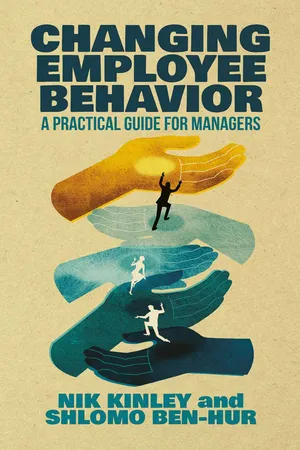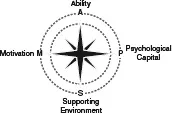![]()
chapter 1
How to Help Change Happen
It is rare to find “behavior change” listed in any job description. It is not even a common phrase used to describe what managers do. But changing people’s behavior is nonetheless something that all managers have to do. And in an increasingly volatile, uncertain, complex, and ambiguous business world, it is something that managers will have to do well if they and their businesses are to succeed.
Often, behavior change is about helping and supporting people to develop themselves. Other times, it is driven more by a manager, who may need people to do certain things or behave in certain ways. Almost always, it is about improving performance.
Almost always, it is about improving performance
It can involve training people in essential skills, improving their ability to work with colleagues, or even trying to stop them from doing something. We may call it coaching, feedback, training, learning, or development, but whatever word we use, what we are doing is trying to change how people behave. We are endeavoring to get them to do something better or different.
The challenge is that changing people’s behavior can be one of the most difficult and complex management tasks. Think about yourself. When was the last time you tried to change your behavior? Deliberately and actively. Not just thought about it, but seriously tried. What was it that you were attempting to change? Perhaps it was something big, like trying to improve a relationship, or something seemingly simpler like reading more books. How did you go about it? And now, be honest: how successful were you? Really. Because if you succeeded, you are probably in a minority.
Take a look at the global annual ritual of new year’s resolutions. Resolving to change some aspect of your behavior or circumstances at the turn of the year is common to many cultures. And somewhere between 50 and 60 percent of people in these cultures say they make just such a resolution. There is a lot of variability in what people resolve to do, but some of the most common goals are getting fit, stopping smoking, and improving personal finances.1 If you ask people a few weeks into the new year how they are doing with these resolutions, the vast majority – around 80 percent – say they are doing well. Even after a month, about 65 percent of people still say they are on track.2 Ask them two years later, though, and fewer than one in five people say they succeeded in changing, and even this figure is probably optimistic.
Perhaps this is why bookstores are heaving with shelves of self-improvement books. They are a weighty testament to the fact that people hope and believe that they can change. Yet they are also proof that people feel they need some help. For all their initial motivation and confidence, translating good intentions into sustained behavior change is far from easy.
If you think changing your own behavior is difficult, how tough must it be to change other people’s behavior? It may not be easy, but it can be done. You just need to know how. You just need to know what to do and which techniques to use. Unfortunately, most managers are working with only a limited set of tools and techniques. They have been taught a model of how to give feedback and coach their staff, and they have resources such as training programs at their disposal. Yet as good and useful as these may be, too often they are just not enough.
Take training programs and development workshops. Even the most wildly optimistic estimates of how much learning from these events is transferred into real behaviors back in the workplace do not go much beyond 34 percent.3 Then there is coaching. An increasing number of organizations use coaching by line managers as a tool for developing people and changing behavior. It has become a standard part of the managerial toolkit, and an amazing 99 percent of HR professionals believe that it can be of benefit.4 Yet only 19 percent believe that the coaching going on in their business is effective, and less than 3 percent of firms even check whether it works.5
only 19 percent believe that the coaching going on in their business is effective
These statistics are really sobering when we remember just how much is spent on this activity. The training market alone was estimated to be worth over $135 billion in 2013.6 Even if we take the most optimistic success rates of 34 percent, that still means $88 billion invested with not much to show for it – every year. And that does not include the coaching and broader development market.
We want to be clear here: we are fans of feedback, training, and coaching. They are essential tools and, done well, they can be highly effective. But most of the time they do not appear to be particularly effective. And this begs the question, why?
What Managers Think
As research for this book, we conducted a global survey with over 500 business leaders and managers. When we asked them what main behaviors they needed to address or improve in others, the top five responses were:
1. Drive and work motivation.
2. Management and supervisory skills.
3. Collaboration and teamwork.
4. Interpersonal skills.
5. Attitude.
Nothing surprising there, nor is there anything unusual in the list of main methods that people report using to change these behaviors. They are the usual suspects of giving feedback, coaching, and training. However, when we asked these leaders and managers how often their attempts to change people’s behavior worked, the response – on average – was around 50 percent of the time. Half the time it seems to work; the other half it does not. In our experience that is an optimistic figure, but even if we take it at face value, it does not look good. Frankly, if you told your boss that in any other aspect of your role you were only successful half the time, he or she would want to know why and what was going wrong.
So we asked managers the same thing. When we asked them how confident they were about helping other people to identify and understand which behaviors they needed to change, just over three-quarters said they found this easy. When we asked how confident they were about giving feedback, almost three-quarters said they felt confident they knew how to do that, too. Yet only 31 percent of them said they felt confident about which techniques to use to help people change behavior, and only 28 percent said they felt confident about being able to motivate people to change. Most worryingly of all, fewer than 10 percent of them said they felt confident about making sure behaviors stayed changed over time (see Figure 1.1). The issue for managers, then, is not what people need to change, but how to do it.
FIGURE 1.1 What managers think
We know behavior change is hard and complex, but it ought to feel easier than this. We should have better success rates than we do and, at the very least, managers ought to feel well-equipped for the task. So something is missing. And this book is designed to fill the gap.
What is Missing
The basic approach to changing behavior that the majority of people use most of the time involves two simple steps. They identify what needs to change and then they try to resolve the issue, usually by providing information – in the form of advice, feedback, or even training – about what new behaviors are needed. “Don’t do this, do that.” “This is the issue, and this is what you need to do about it.” Or, “What do you want to achieve? Now let’s think together about how you can do it.” They identify, and they resolve (see Figure 1.2).
FIGURE 1.2 The basic two-step method of behavior change
This two-step problem-solving method is common to all aspects of life. It is simple, basic, and fundamental. Parents do it. Friends do it. Managers do it. Over the past 20 years, managers have become increasingly sophisticated about how they do it, too. Since the early 1990s, training managers how to coach people has become commonplace, and these days coaching is a standard piece of the managerial toolkit.
To help managers coach their people, a large number of different coaching models and approaches have emerged. Probably the most famous such model is the GROW model.7 The G stands for “goal” and is all about helping people identify what they want to achieve. The R stands for “reality” and is about helping people understand where they are now and how far they are away from their goal. The O is all about identifying both the “obstacles” and “options” facing people. Finally, the W refers to planning a “way forwards.” As models go, GROW is pretty good, too. It is clear, practical, and results-focused.
What GROW and all the other coaching models do is to offer a more structured and sophisticated way of approaching the basic two-step method for changing behavior (see Figure 1.3). They enable us to question the issues involved and make sure we really understand them. They help us set better goals and develop effective action plans. And they remind us to track people’s progress.
FIGURE 1.3 A typical coaching model for changing behavior
Yet despite the seemingly endless range of coaching models available almost all of them share two basic faults. First, they have more to say about the process managers have to follow and the steps they have to take than about the techniques they can use. For example, they may suggest that you “first discuss this, then that,” but tend to be less clear on how to discuss it. Or they may suggest that you write a plan for changing a behavior, but say less about what kinds of activities can be included in the plan. And when they do suggest techniques, they tend to describe only a very limited range. So they set a clear path for people to follow, but tend not to provide all the tools to get there. Part of the aim of this book is to set this right and to provide a much broader set of tools and techniques for managers to use.
Our second concern with so many coaching models is that their main focus is still on the two basic steps. It may be a more sophisticated version, but the focus is still on identifying what people need to change and what they need to do. This may sound reasonable and essential, and it is. Managers undoubtedly need to help people do these things. In fact, behavior change cannot work unless managers do help people do them. But these two steps ignore everything else that is going on around the change and which can have a huge impact on it: the environment and conditions in which change happens.
The Power of Context
One of the clearest examples of the importance of context in behavior change comes from an unusual place: studies of whether criminals reoffend after they have been released from prison. Reoffending rates vary depending on the type of prisoner and the type of offense they committed. Overall, though, evidence from the UK, Europe, the US, and Australia suggests that between 40 and 60 percent of prisoners released from prison reoffend within 12 months.8
Looking at the difference between those who reoffend and those who manage not to, two major factors stand out. First, treatment or attending some kind of change program seems to help, although ex...




